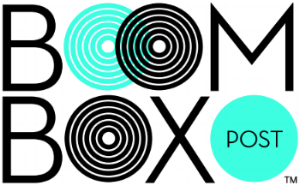WRITTEN BY KATE FINAN, CO-OWNER OF BOOM BOX POST
This November, we hosted Women’s Audio Mission for a workshop on Creative Sound Design for Film & TV.
If you have not heard of the Women’s Audio Mission, they are an amazing non-profit organization whose purpose is “changing the face of sound by providing hands-on training, work experience, career counseling, and job placement to over 2,000 women/girls/gender-expansive individuals every year in creative technology for music, radio, film, television, and the internet.”
At Boom Box Post, we believe that diversity is a key ingredient in every workplace, but especially for those in creative industries like our own where each person brings their own experience, culture, and perspective to their creative process. We pride ourselves in maintaining a staff that reflects the varied mosaic of the real world and have maintained a 50% female and gender-expansive staff since first opening our doors.
Because our core values at Boom Box Post encompass creativity, collaboration, diversity, inclusivity, and education, our partnership with WAM over the years to provide high-quality hands-on workshops to their members has been an obvious extension of those values. We are happy to volunteer our time and our studio to help them to change the face of sound.
The Workshop
The sold-out event began with a short mixer as the attendees arrived. I was able hear from nearly all of the individuals about their unique career paths, their experiences in the industry, and what they were hoping to get out of the workshop. After about half an hour, I led the group into our mix stage, and the workshop began! Gemma Castro (music producer, audio engineer, and WAM personnel) started us off by talking about the Women’s Audio Mission and their goals and services. Then, she handed it off to me.
I began by getting everyone on the same page about what sound design is, or at least what I was defining it as for the purposes of our workshop. Here is my definition:
Sound design is the art and practice of creating sound for film and television. It involves sourcing audio elements by recording or acquiring sound effect libraries, editing and layering those elements to match picture, and possibly altering them with audio tools.
Then, I broke down the elements that need sound design into two groups:
Backgrounds/ambiences to establish the sounds of a location, often consisting of unseen elements
Hard FX which sync to the picture
After that, we began the interactive part of the workshop where we designed the sound for a short clip from top to bottom. We started with backgrounds, and then moved on to hard sound effects. For each part, I gave my tips and tricks for creating balanced and creatively interesting sound design that will really stand out in the mix. Then, I took suggestions from the attendees for Soundminer search terms and as well as general creative direction for our builds. Along the way, we discussed boolean search engines, how and why we layer, balancing the frequency spectrum with each build, and always striving to add interesting textures with our elements. I have to say that we created a distinctive, bolt, and interesting soundscape together.
Finally, we had a robust Q&A with no shortage of questions about workflow, session layout and organization, how to boost yourself out of a creative slump, and more.








Additional Resources
Our Q&A inspired me to pull additional blog posts that include even more information on the topics that came up. I have a feeling that if the young professionals in attendance had questions in these areas, that many of our blog followers probably do to. So, if you’re starting your post-production journey, looking to branch out to a position in sound design, or are just brushing up on your skills, here are some fantastic resources to check out:
DOWNSTREAM: VALUABLE SOUND DESIGNERS THINK LIKE MIXERS
Topics covered:
Perspective Cutting
Color Coding
Clip Gain vs Automation
Food Groups
LAYING IT ALL OUT THERE: WHEN A GOOD LOOKING LAYOUT IS ACTUALLY BAD
Topics covered:
Perspective Cutting
Stair Stepping
Color Coding
Clip Gain vs Automation
Food Groups
ESSENTIAL SKILL: HOW TO PROPERLY EDIT SOUND FOR PERSPECTIVE SHIFTS
Topics covered:
Perspective Cutting
FIVE THINGS I'VE LEARNED ABOUT EDITING FROM MIXING
Topics covered:
Perspective Cutting
Color Coding
Clip Gain vs Automation
SPEAK VOLUMES THROUGH WELL ORGANIZED WORK
Topics covered:
Stair Stepping
Food Groups
BACKGROUNDS, AMBIENCES, OR SOUND EFFECTS?
Topics covered:
The difference between backgrounds, ambiences, and sound effects
How to lay them out in your sessions
HOW TO GET A JOB AS A SOUND EDITOR
Topic covered:
How to make your demo reel
How to reach out to a studio
Education, internships, and work experience
SUREFIRE TIPS TO HELP YOU SUCCEED IN YOUR NEXT JOB INTERVIEW
Topics covered:
Your cover letter & resume
Preparing for you interview
To learn more about Women’s Audio Mission, please visit their website. They are a true gem! If you attended and want to share your experience, or if you have any ideas for future workshops, please comment below!

